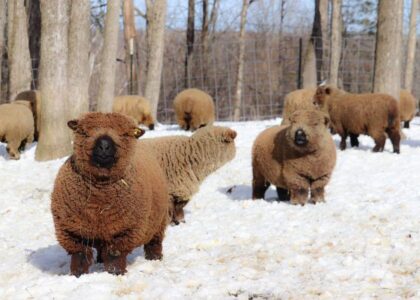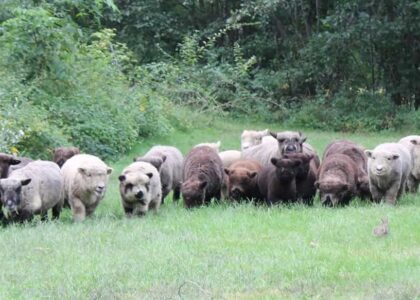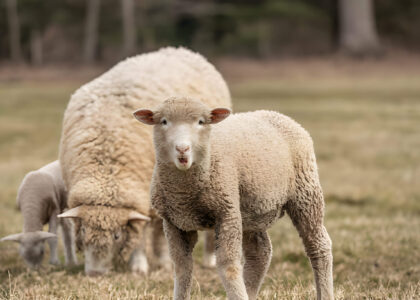Babydoll sheep colors , known for their adorable appearance and manageable size, have become a sought-after addition to farms and homesteads. Beyond their compact build and gentle temperament, one fascinating aspect that captivates enthusiasts is the array of colors these charming creatures can exhibit.
Babydoll sheep colors : Natural Colors
White: The Classic Hue
Babydoll sheep are often associated with their classic white color, reminiscent of fluffy clouds grazing in the fields. This timeless hue is not only visually appealing but also symbolizes purity and innocence.
Cream: A Soft Variation
For those seeking a softer palette, babydoll sheep can also display a lovely cream color. This variation adds a touch of warmth to the flock, creating a picturesque scene against the backdrop of green pastures.
Brown: Earthy Tones
Some babydoll sheep showcase earthy brown tones, blending seamlessly with the natural environment. This variation adds a rustic charm to the flock, evoking a connection to the pastoral landscape.
Black: Striking and Beautiful
In a striking contrast, babydoll sheep can flaunt a sleek black coat. This color not only adds a touch of elegance but also emphasizes the unique features of these miniature wonders.
Factors Influencing Babydoll Sheep Colors
Genetics and Inheritance
The color palette of babydoll sheep is intricately tied to their genetics. Understanding the principles of color inheritance is crucial for breeders aiming to produce specific hues in their flock.
Environmental Factors
Beyond genetics, environmental conditions play a role in determining the intensity and vibrancy of babydoll sheep colors. Factors such as sunlight exposure and climate can influence coat pigmentation.
Breeding Practices for Color Enhancement
Selective Breeding
Breeders often employ selective breeding techniques to enhance or maintain specific colors within the babydoll sheep population. This involves carefully choosing parent sheep with desired color traits.
Understanding Color Genetics
Delving into the world of color genetics is essential for breeders aiming to predict and control the color outcomes in their babydoll sheep. Knowledge about dominant and recessive genes guides breeding decisions.
The Significance of Colors in Babydoll Sheep
Aesthetics and Personal Preferences
The color of babydoll sheep goes beyond mere aesthetics; it reflects the personal preferences of breeders and enthusiasts. Some may prefer the classic white, while others are drawn to the uniqueness of less common hues.
Market Trends and Demand Of Babydoll sheep colors
In the world of livestock, market trends influence breeding practices. Understanding the demand for specific colors can be a driving factor for breeders looking to cater to the preferences of potential buyers.
Challenges in Maintaining Color Consistency
Unpredictable Genetic Outcomes
Despite meticulous breeding practices, the unpredictable nature of genetics can lead to unexpected color outcomes. This unpredictability adds an element of excitement but also poses challenges for maintaining color consistency.
Environmental Challenges
External factors like exposure to harsh weather conditions or inadequate shelter can affect the vibrancy and longevity of babydoll sheep colors. Addressing these challenges is crucial for breeders seeking consistent coloration.
Tips for Babydoll Sheep Color Maintenance
Proper Nutrition
Ensuring that babydoll sheep receive a balanced and nutritious diet is vital for maintaining the health of their coats. Proper nutrition contributes to vibrant colors and overall well-being.
Shelter and Environmental Control
Providing adequate shelter and environmental control helps mitigate the impact of external factors on coat color. This is especially important in regions with extreme weather conditions.
Beyond Color: Other Unique Characteristics
Size and Compact Build
While color is a captivating aspect, the size and compact build of babydoll sheep are equally endearing. Their manageable size makes them suitable for small spaces and easy to handle.
Temperament and Livestock Management
In addition to their physical characteristics, babydoll sheep are known for their gentle temperament. Effective livestock management includes understanding their behavior and ensuring their well-being.
Caring for Babydoll Sheep
General Care Guidelines
Proper care for babydoll sheep involves regular health checks, vaccinations, and access to clean water and nutritious feed. Following general care guidelines contributes to the overall health and happiness of the flock.
Health Considerations
Vigilant monitoring of the health of babydoll sheep is essential. Regular veterinary visits, parasite control, and prompt attention to any signs of illness contribute to a thriving and resilient flock.
Common Misconceptions about Babydoll Sheep Colors
Limited to White
Contrary to common belief, babydoll sheep are not limited to white coats. The diverse range of colors adds to their appeal and allows breeders to explore and showcase the beauty of nature’s palette.
Natural Color Changes Over Time
The color of babydoll sheep can undergo natural changes over time. Understanding and appreciating these shifts as part of the aging process contributes to a deeper connection with these remarkable animals.
Engaging with the Babydoll Sheep Community
Online Forums and Communities
Enthusiasts and breeders can connect and share experiences on online forums dedicated to babydoll sheep. These platforms offer a wealth of knowledge and a sense of community.
Local Events and Shows
Participating in local events and shows provides opportunities to showcase babydoll sheep and learn from other breeders. These gatherings foster a sense of camaraderie among those passionate about these miniature marvels.
The Future of Babydoll Sheep Colors
Breeding Innovations
Advancements in breeding technologies and a deeper understanding of genetics are likely to influence the future colors of babydoll sheep. Breeders may explore innovative ways to create new and unique color variations.
Emerging Trends
Keeping an eye on emerging trends in the livestock industry can guide breeders in adapting to changing preferences. Staying informed ensures that babydoll sheep continue to capture hearts with their captivating colors.
Emerging trends in the world of babydoll sheep colors showcase a shift towards unique and unconventional hues. Breeders are exploring innovative genetic combinations to create distinct and eye-catching color variations. The demand for rare and non-traditional colors is on the rise, reflecting a growing appreciation for diversity in livestock. Additionally, a focus on sustainable and eco-friendly practices in breeding is becoming a noteworthy trend. As the community of babydoll sheep enthusiasts evolves, these emerging trends contribute to the dynamic and vibrant landscape of color choices in these charming miniature creatures.
Conclusion
In the world of babydoll sheep, colors contribute to the unique tapestry of each flock. From classic whites to earthy browns and striking blacks, these miniature wonders bring joy and diversity to farms and homesteads. Understanding the factors influencing their colors, the challenges in maintaining consistency, and the significance beyond aesthetics is crucial for breeders and enthusiasts alike.
In conclusion, babydoll sheep colors, ranging from classic whites to earthy browns, contribute to the charm of these miniature wonders. Understanding genetic influences and environmental factors is crucial for breeders. Challenges in maintaining color consistency highlight the need for attentive care. Beyond aesthetics, colors reflect personal preferences and market trends. Looking ahead, innovations in breeding and community engagement will shape the future of these endearing creatures.
Frequently Asked Questions (FAQs)
- Can babydoll sheep change color as they age?
Babydoll sheep may undergo natural color changes over time, adding to their unique characteristics. - Is selective breeding the only way to influence babydoll sheep colors?
While selective breeding is a common practice, environmental factors also play a role in determining coat colors. - Do babydoll sheep require special care based on their colors?
Proper nutrition and environmental control are essential for maintaining vibrant colors, irrespective of the hue. - Are there restrictions on participating in babydoll sheep shows based on color?
Most shows appreciate the diversity of colors, and there are usually no restrictions based on coat color. - How can I connect with other babydoll sheep enthusiasts?
Online forums, social media groups, and local events are great avenues to connect with fellow babydoll sheep enthusiasts.




